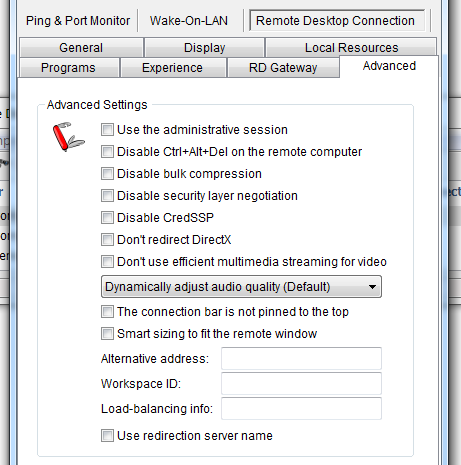
- MICROSOFT REMOTE DESKTOP CONNECTION INCREASE FONT SIZE PASSWORD
- MICROSOFT REMOTE DESKTOP CONNECTION INCREASE FONT SIZE PC
- MICROSOFT REMOTE DESKTOP CONNECTION INCREASE FONT SIZE WINDOWS
1: Use RDP-efficient multimedia streaming for video playback when possible. 0: Don't use RDP efficient multimedia streaming for video playback. 1: Enable RDP bulk compression.ĭetermines if the connection will use RDP-efficient multimedia streaming for video playback. 1: Use automatic network bandwidth detection.ĭetermines whether bulk compression is enabled when it's transmitted by RDP to the local computer. 0: Don't use automatic network bandwidth detection.

1: Enable automatic network type detection.ĭetermines whether automatic network type detection is enabled. 0: Disable automatic network type detection. Requires bandwidthautodetect to be set to 1.

1: Client automatically tries to reconnect.ĭetermines whether or not to use automatic network bandwidth detection. 0: Client doesn't automatically try to reconnect. 1: Initiate new connection.ĭetermines whether the client will automatically try to reconnect to the remote computer if the connection is dropped, such as when there's a network connectivity interruption. 3: No authentication requirement specified.ĭetermines whether the client reconnects to any existing disconnected session or initiate a new connection when a new connection is launched. 2: If server authentication fails, show a warning, and choose to connect or refuse the connection. 1: If server authentication fails, don't establish a connection. 0: If server authentication fails, connect to the computer without warning. 1: Remote session will use the same credentials.ĭefines the server authentication level settings. 0: Remote session won't use the same credentials. Setting this property value to 0 or 4 are effectively equivalent, but setting this property to 4 enables the option to bypass local addresses.ĭetermines whether a user's credentials are saved and used for both the RD Gateway and the remote computer. 4: Don't use an RD Gateway, bypass gateway for local addresses. 3: Use the default RD Gateway settings. 2: Use an RD Gateway if a direct connection can't be made to the RD Session Host. Specifies when to use an RD Gateway for the connection. 1: Use explicit settings, as specified by the user. 0: Use the default profile mode, as specified by the administrator. Specifies whether to use default RD Gateway settings. 3: Prompt the user for their credentials and use basic authentication. 2: Use the credentials for the currently signed in user. Specifies the RD Gateway authentication method. Specifies the name of the domain in which the user account that will be used to sign in to the remote computer is located. Specifies the name of the user account that will be used to sign in to the remote computer. Specifies an alternate name or IP address of the remote computer. This is the only required setting in an RDP file.Ī valid name, IPv4 address, or IPv6 address. This setting specifies the hostname or IP address of the remote computer that you want to connect to. Valid path to a KDC proxy server, such as. Specifies the fully qualified domain name of a KDC proxy.

Valid path to an executable file, such as C:\ProgramFiles\Office\word.exe. Specifies a program to be started automatically in the remote session as the shell instead of explorer. 1: RDP will use CredSSP if the operating system supports CredSSP. 0: RDP won't use CredSSP, even if the operating system supports CredSSP.
MICROSOFT REMOTE DESKTOP CONNECTION INCREASE FONT SIZE PASSWORD
1: connections to Azure AD-joined hosts will succeed but are restricted to entering user name and password credentials when connecting to session hosts.ĭetermines whether the client will use the Credential Security Support Provider (CredSSP) for authentication if it's available.
MICROSOFT REMOTE DESKTOP CONNECTION INCREASE FONT SIZE WINDOWS
0: connections to Azure AD-joined session hosts will succeed for Windows devices that meet the requirements, but other connections will fail. Note: only applicable to non-Windows clients and local Windows devices that aren't joined to Azure AD.
MICROSOFT REMOTE DESKTOP CONNECTION INCREASE FONT SIZE PC
1: RDP will use Azure AD authentication if the remote PC supports it.Īllows connections to Azure AD-joined session hosts using username and password. 0: RDP won't use Azure AD authentication, even if the remote PC supports it. This replaces the property targetisaadjoined. Note: Available in preview for Windows and web clients only currently. Connection information Display nameĭetermines whether the client will use Azure AD to authenticate to the remote PC if it's available. Use the following tables to understand each setting and whether it applies whenĬonnecting to Remote Desktop Services, Azure Virtual Desktop, or both. Services compared to Azure Virtual Desktop. Supported RDP properties differ when using Remote Desktop


 0 kommentar(er)
0 kommentar(er)
